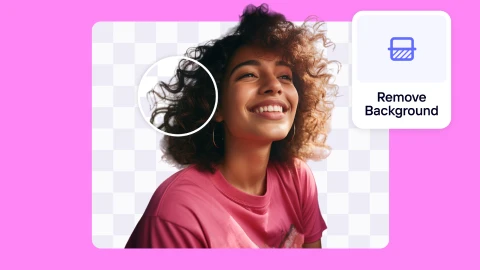Top 5 AI photo editor APIs
Imagine a world where the painstaking photo editing process, battling with software features, and spending hours getting that perfect shot are gone. Now, what if we told you that this isn't the premise of a new sci-fi film, but the reality brought to us by AI photo editing. Through this, the power to enhance, develop, and polish photos is now at our fingertips, completely changing how we create, share, and engage with visual content.
But how do developers and businesses leverage this power? Enter AI photo editing APIs, easily integrating these tools into existing programs. They open up a whole new level of image manipulation, removing the time-consuming manual editing process and allowing automation, scalability, and advanced features previously unavailable.
And if you're wondering how to navigate this evolving landscape and choose the best AI image editing tool for your needs, you're in the right place. Keep reading to learn about the top 5 APIs changing the game and how they can empower your business by taking your visuals to the next level.
What does an API of an AI photo editor do?
AI photo editing APIs are essentially software programs that allow developers to integrate various functionalities into their applications. Unlike traditional editing software, these APIs leverage the potential of deep learning and object recognition to analyze and manipulate images with accuracy and automation.

Automation: Streamline complex editing tasks and reduce processing time - particularly key for those looking to simplify their image editing workflows
Visual appeal: Gone are the days of bland white backgrounds. Using APIs, marketers can add dynamic AI-generated backgrounds, shadows, and lighting enhancements, making their products more visually appealing to consumers
Scalability: Handle large volumes of images with ease
Advanced features: Access functionalities like background removal, object removal and replacement, noise reduction, photo enhancement, and even creative style transfer
Customization: Many APIs also offer customization options to tailor the editing process to specific needs
Boost ad asset creation: APIs allow brands to create unlimited ad combinations that can be tested to improve results. Photoroom recently conducted an A/B/C Facebook ad test using different ad photos created with Gen AI backgrounds and shadows to better understand images' impact on ad performance. The result? Using the Gen AI ad image variant improved performance by 34%
What defines a good AI photo editor API?
Features: Identify the specific functionalities you need, such as background removal, object manipulation, or even generating specific backgrounds to give products that extra visual boost
Ease of integration: Make sure the API offers clear documentation, code examples, and a smooth integration process
Implementation time: APIs for image editing can save you a lot of time and manual labor, which is one of their main benefits. But check that the implementation time is feasible and allows a smooth transition
Image quality: A key factor in processed rendering is the quality of the image, as it affects the amount of manual editing required. Make sure to pay close attention to the quality output during the testing and trial period.
Cost: Research pricing models and choose an API that aligns with your budget and project needs
Options for bulk editing: When you process hundreds or thousands of images daily, you might need to consider streamlining your image workflow. So make sure that the API you chose can handle your volume
Customization: Lastly, depending on the level of customization you need, check out the available solutions. Every API is different, and so are your unique needs!
The best AI photo editors that offer an API
We considered various leading industry voices and reports to create this shortlist, such as those by Andreessen Horowitz, Digital Camera World, and Zapier. Now, let's dive into the top 5 AI photo editor APIs that are making waves in 2024. Now, let's dive into the top 5 AI photo editor APIs that are making waves in 2024!
1. Photoroom
The Photoroom API offers a range of AI-powered editing features with technology designed to cater to both individual and business needs, allowing users to produce professional-grade images with minimal effort.
Whether it's for product photography or image manipulation, Photoroom certainly delivers a streamlined solution. Let's take a look at some of these:
Remove Background API: Provides a swift and accurate solution for detaching subjects from their backgrounds - perfect for brand activations, content creation, and portrait shots
Image Editing API: Automates the enhancement and customization of images, offering features like positioning, object removal, AI generated backgrounds, shadows and relighting - to enhance under or overexposure - ideal for ad asset generation, marketplace and e-commerce product listings, product customization, and many more industries.
How much does Photoroom cost?
Photoroom offers a free trial to all users. The following prices apply after the trial period:
| Cost | Plan |
|---|---|
| Pro | $7.50 per month/billed annually $12.99 per month /billed monthly |
| Max | $20.99 per month/billed annually $34.99 per month/billed monthly |
| Ultra | From $82.50 per month/billed annually From $99 per month/billed monthly |
| Enterprise | Contact the sales team |
2. Photoshop Generative Fill
This API, developed by Adobe, is a game-changer for photographers and designers, simplifying complex editing tasks and improving efficiency with features such as:

Content-Aware Fill: Automatically analyzes and fills selected areas with relevant textures and elements from the surrounding image
Pattern Recognition: Identifies patterns in the image to ensure smooth blending when filling areas or removing objects
Customizable Outputs: Offers users control over the fill result, allowing precise adjustments to match the creative vision
3. Luminar Neo
Luminar Neo specializes in applying AI for photo enhancement, particularly in landscapes and portraits. It's designed with tools that intuitively adapt to a photo's unique requirements and elevate overall quality.

AI Enhancement: Automatically optimizes photos for lighting, details, and composition with just a click
Sky Replacement: Transforms skies in photos using AI, adjusting the scene's mood without manual masking
Portrait Bokeh AI: Creates stunning bokeh effects for portraits, mimicking the depth of field from professional lenses
4. Midjourney
This text-to-image generation platform utilizes AI to create unique and artistic images based on user descriptions.

Enhanced detail and realism: Midjourney V6 has improved its ability to generate more photorealistic images, blurring the lines between AI-generated art and actual photographs.
Advanced prompt understanding: It can also follow longer and more complex prompts. This means the AI can now better understand and execute detailed instructions, leading to more accurate depictions of the user's vision.
Text overlays: Midjourney V6 introduces new features, such as adding text overlays to images, offering a new dimension of creativity.
5. DALL-E 3
DALL-E 3 is another specialist in text-to-image conversion technology, appealing to users with its ability to craft detailed and imaginative visuals from simple textual prompts.

Enhanced understanding and precision: DALL-E 3 can grasp complex instructions and prompts, producing images that closely align with the user's descriptions.
Integration with ChatGPT: Using the capabilities of ChatGPT, DALL-E 3 allows prompt editing and image adjustments, acting as a creative partner to users.
Quality options and new sizes: DALL-E 3 introduces 'standard' and 'HD' quality settings, allowing users to choose the level of detail in their generated images. It also supports various image sizes, providing greater flexibility in terms of aspect ratio and composition.
How to get started with an AI photo editor API
Integrating an AI photo editor API depends on the specific platform and documentation offered. Generally, the process is simple and fast, involving:
Signing up: The easiest part! Start by creating an account with the chosen API provider
Acquiring API keys: These keys act as your access credentials for integrating the API into your project
Documentation review: Carefully study the API documentation provided to understand the functionalities and syntax
Coding implementation: Integrate the API code into your project using the provided documentation and code examples
Testing: Thoroughly test the API integration to ensure it functions as expected
Picking the right AI photo editor API can boost your creative output and streamline your workflow. Whether you're a developer building a photo editing application or a business looking to enhance product visuals, these APIs offer a powerful solution that saves time, improves efficiency, and unlocks new creative possibilities.
Remember, choosing the best option depends on your specific needs and project requirements. Explore the diverse market, compare additional features, and don't hesitate to experiment to discover the perfect partner for your vision.
📌Ready to experience the future now? Give Photoroom's AI-powered photo editing tools a go! Sign up now.
Frequently Asked Questions
What are the benefits of using an AI photo editor API compared to traditional photo editing software?
AI photo editor APIs offer automation, scalability, and advanced editing capabilities not typically found in traditional photo editing software. They can process images in bulk, learn from data to improve outcomes and carry out complex editing tasks with minimal human intervention, saving time and resources while delivering consistent, high-quality results.
What are some examples of how AI photo editing APIs can be used in businesses?
AI photo editing APIs can streamline product photography for e-commerce by automating background removal and enhancing product images, personalize customer experiences with customized visual content, support social media marketing through quick and tailored image adjustments, and facilitate content creation for digital advertising by generating and optimizing visuals at scale.
Do I need coding experience to use an AI photo editor API?
While some basic coding knowledge is helpful, many APIs offer user-friendly interfaces and no-code solutions. Photoroom, for example, has Zapier integration so you can use its pre-configured options or create your own using no-code. It ultimately depends on the specific API and the level of customization you are after.
Related articles:




Design your next great image
Whether you're selling, promoting, or posting, bring your idea to life with a design that stands out.

















